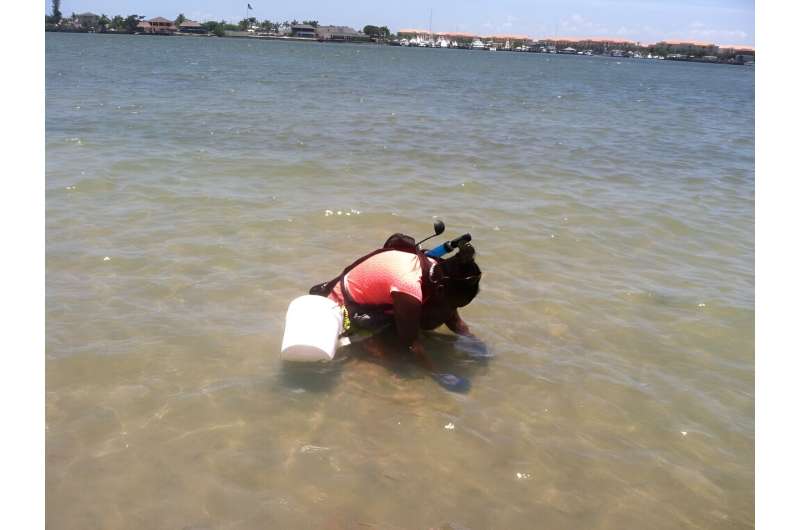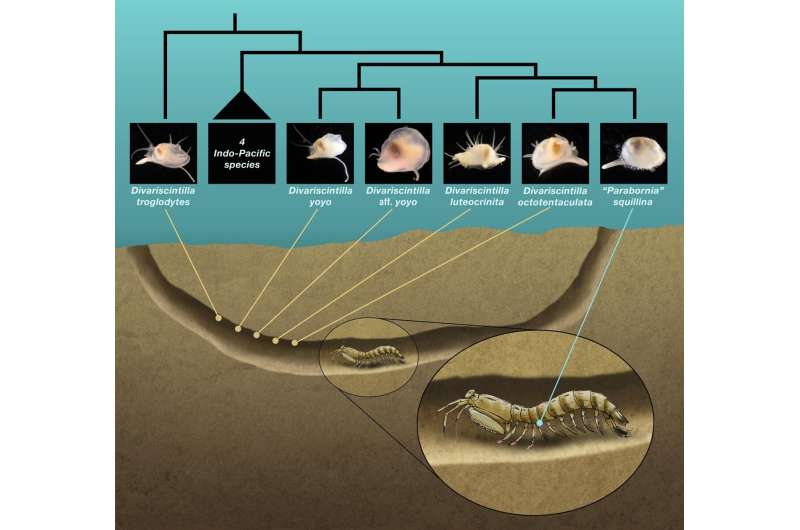
When clams gamble on living with a killer, sometimes their luck may run out, according to a University of Michigan study.
A longstanding question in ecology asks how can so many different species co-occur, or live together, at the same time and at the same place. One influential theory called the competitive exclusion principle suggests that only one species can occupy a particular niche in a biological community at any one time.
But out in the wild, researchers find many instances of different species that appear to occupy the same niches at the same time, living in the same microhabitats and consuming the same food.
U-M ecology and evolutionary biology graduate student Teal Harrison and her adviser Diarmaid Ó Foighil examined one such instance: a highly specialized community of seven marine clam species living in the burrows of their host species, a predatory mantis shrimp.
Six of these seven clam species, called yoyo clams, attach to the shrimp’s burrow walls with a long foot used to spring, yoyo-like, away from danger. The seventh of the clam species, a close relative of the yoyo clams, has a distinct within-burrow niche in that it attaches directly to the host mantis shrimp’s body and does not yoyo. The researchers wondered how this unusual clam community persists.
“We’ve got this remarkable situation where all these clam species not only share the same host but most of them have also evolved, or speciated, on that host. How is this possible?” said Ó Foighil, also a curator of mollusks at the U-M Museum of Zoology.

When Harrison conducted field samples of these clam species in mantis shrimp burrows, what she found went against theoretical expectations: all burrows that contained multiple species of clams were composed solely of the burrow wall yoyo clams. And when the host-attached clam species was added to the mix in a laboratory experiment, the mantis shrimp killed all of the burrow-wall clams.
This goes against theoretical expectation, the researchers say. According to the competitive exclusion principle, species that evolve to live in different niches should live together more frequently than species that occupy the same niche. But Harrison’s data, published in the journal PeerJ, suggest that the evolution of a new, host-attached niche has paradoxically led to ecological exclusion, not cohabitation, among these commensal clams.
“Teal had two sets of unexpected results. One of them was that the species that should co-occur with the yoyo clams doesn’t. And the second unexpected result was that the host can go rogue,” Ó Foighil said. “The interesting twist is the only survivor was a clam attached to the mantis shrimp’s body. Anything on the burrow wall, it killed. It even went outside the burrow and killed one that had wandered out.”
The competitive exclusion principle predicts that the six yoyo clam species (which share the burrow-wall niche) will co-occupy host burrows less frequently with each other than with the (niche-differentiated) host-attached clam species. Harrison tested this prediction by field-censusing populations in the Indian River Lagoon, Florida. This involved carefully capturing host mantis shrimp by hand and sampling their burrows for clams using a stainless-steel bait pump.
Harrison then built artificial burrows in the laboratory where she could study, up close, commensal clam behavior with and without a mantis shrimp host. Less than three days after setup, almost all of the clams in the mantis shrimp’s burrow were dead.
“It was very surreal,” Harrison said. “It honestly didn’t even dawn on me that they were eaten right away because it was so far from what I was expecting to find. They are commensal organisms, they cohabitate with these mantis shrimp in the wild, and there was no possible way we would know whether this behavior was already happening this way in the wild or not. I just wasn’t expecting it.”

Harrison was devastated. Ó Foighil was excited.
“Teal was understandably distraught when the experiment ‘failed’ after all her hard work, but I was excited,” Ó Foighil said. “When you get a completely unexpected result in science, it’s potentially telling you something brand new and important.”
The researchers say that the exclusion mechanism—blocking burrow-wall and host-attached clam co-occurrence—is currently unclear. One reason could be that during the larval stage, burrow wall clams recruit to different host burrows than the host-attached clams. But it also could be differential survival in burrow assemblages that have both burrow wall and host-attached clams—that is, potentially that mixed population of clams triggers a lethal reaction in the host, Ó Foighil said.
The researchers’ next steps are to look into what happened. It could have been an artifact of the setup in the lab, Ó Foighil said. Or it could be telling the researchers that under some conditions, the commensal association of the burrow wall yoyo clams and the predatory host can “break down catastrophically,” he said.
“It was pretty cool to have a finding that was contrary to what we were expecting based on evolutionary theory, and it was not only contrary to our theoretical expectations, but it happened in such a dramatic way,” Harrison said.
The researchers have proposed two follow-up studies. The first is to determine if both types of commensals can recruit as larvae to the same host burrows. The second to test whether the mantis shrimp itself is the culprit: does its predatory behavior change when the host-attached species is added to its burrow?
Study co-authors include Ryutaro Goto of Kyoto University, who initiated this line of work as a postdoctoral researcher in Ó Foighil’s lab, and Jingchun Li of the University of Colorado, also a former graduate student in the Ó Foighil lab.
More information:
Teal A. Harrison et al, Within-host adaptive speciation of commensal yoyo clams leads to ecological exclusion, not co-existence, PeerJ (2024). DOI: 10.7717/peerj.17753
Journal information:
PeerJ
Provided by
University of Michigan
Citation:
Living with a killer: How an unlikely mantis shrimp-clam association violates a biological principle (2024, August 6)
retrieved 6 August 2024
from https://phys.org/news/2024-08-killer-mantis-shrimp-clam-association.html
This document is subject to copyright. Apart from any fair dealing for the purpose of private study or research, no
part may be reproduced without the written permission. The content is provided for information purposes only.
